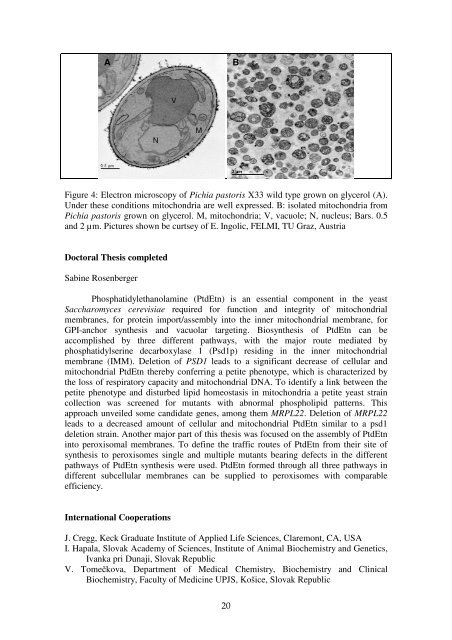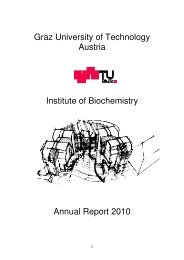Staff Members of the Institute of Biochemistry, TU Graz http://www ...
Staff Members of the Institute of Biochemistry, TU Graz http://www ...
Staff Members of the Institute of Biochemistry, TU Graz http://www ...
Create successful ePaper yourself
Turn your PDF publications into a flip-book with our unique Google optimized e-Paper software.
A<br />
B<br />
V<br />
N<br />
M<br />
Figure 4: Electron microscopy <strong>of</strong> Pichia pastoris X33 wild type grown on glycerol (A).<br />
Under <strong>the</strong>se conditions mitochondria are well expressed. B: isolated mitochondria from<br />
Pichia pastoris grown on glycerol. M, mitochondria; V, vacuole; N, nucleus; Bars. 0.5<br />
and 2 µm. Pictures shown be curtsey <strong>of</strong> E. Ingolic, FELMI, <strong>TU</strong> <strong>Graz</strong>, Austria<br />
Doctoral Thesis completed<br />
Sabine Rosenberger<br />
Phosphatidylethanolamine (PtdEtn) is an essential component in <strong>the</strong> yeast<br />
Saccharomyces cerevisiae required for function and integrity <strong>of</strong> mitochondrial<br />
membranes, for protein import/assembly into <strong>the</strong> inner mitochondrial membrane, for<br />
GPI-anchor syn<strong>the</strong>sis and vacuolar targeting. Biosyn<strong>the</strong>sis <strong>of</strong> PtdEtn can be<br />
accomplished by three different pathways, with <strong>the</strong> major route mediated by<br />
phosphatidylserine decarboxylase 1 (Psd1p) residing in <strong>the</strong> inner mitochondrial<br />
membrane (IMM). Deletion <strong>of</strong> PSD1 leads to a significant decrease <strong>of</strong> cellular and<br />
mitochondrial PtdEtn <strong>the</strong>reby conferring a petite phenotype, which is characterized by<br />
<strong>the</strong> loss <strong>of</strong> respiratory capacity and mitochondrial DNA. To identify a link between <strong>the</strong><br />
petite phenotype and disturbed lipid homeostasis in mitochondria a petite yeast strain<br />
collection was screened for mutants with abnormal phospholipid patterns. This<br />
approach unveiled some candidate genes, among <strong>the</strong>m MRPL22. Deletion <strong>of</strong> MRPL22<br />
leads to a decreased amount <strong>of</strong> cellular and mitochondrial PtdEtn similar to a psd1<br />
deletion strain. Ano<strong>the</strong>r major part <strong>of</strong> this <strong>the</strong>sis was focused on <strong>the</strong> assembly <strong>of</strong> PtdEtn<br />
into peroxisomal membranes. To define <strong>the</strong> traffic routes <strong>of</strong> PtdEtn from <strong>the</strong>ir site <strong>of</strong><br />
syn<strong>the</strong>sis to peroxisomes single and multiple mutants bearing defects in <strong>the</strong> different<br />
pathways <strong>of</strong> PtdEtn syn<strong>the</strong>sis were used. PtdEtn formed through all three pathways in<br />
different subcellular membranes can be supplied to peroxisomes with comparable<br />
efficiency.<br />
International Cooperations<br />
J. Cregg, Keck Graduate <strong>Institute</strong> <strong>of</strong> Applied Life Sciences, Claremont, CA, USA<br />
I. Hapala, Slovak Academy <strong>of</strong> Sciences, <strong>Institute</strong> <strong>of</strong> Animal <strong>Biochemistry</strong> and Genetics,<br />
Ivanka pri Dunaji, Slovak Republic<br />
V. Tomekova, Department <strong>of</strong> Medical Chemistry, <strong>Biochemistry</strong> and Clinical<br />
<strong>Biochemistry</strong>, Faculty <strong>of</strong> Medicine UPJS, Košice, Slovak Republic<br />
20














